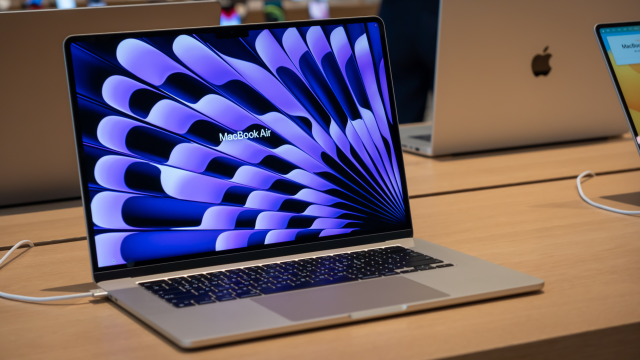Apple quietly announced the new M3-powered MacBook Air this week, bringing the M3 chip to the company’s most affordable and lightweight computers. But with less than a year since it release, the M2 MacBook Air is still a really solid laptop computer. Here’s a rundown of the differences between these two great laptops, plus some pointers on how to choose between them.
Performance
Obviously, Apple has added a newer and faster performing chipset to the M3 MacBook Air. It’s based on the A17 Pro Chip that’s featured in the iPhone 15 Pro Max, and it’s built on a 3nm node, making it more efficient. It also has 25 billion transistors compared to the 20 billion transistors found in the M2 MacBook Air, and is registered at a 4.05 Ghz CPU clock speed compared to the 3.49 Ghz CPU clock speed on the M2 MacBook Air.
The M3 chip in the new MacBook Air also introduces a 15% faster Neural Engine, which Apple says it will be using to power more AI-related things in the future. There’s also an improved and new GPU architecture, which makes the M3 chip more efficient and faster than the GPU found in the M2, and it has hardware-accelerated ray tracing and mesh shading.
All of that comes together to create a chipset that runs smoother and faster than the one found in the M2 MacBook Air. If you want some numbers to look at, the M3 MacBook Air scored a 3,157 in single-core tests and 12,020 in multi-core tests on GeekBench (via NotebookCheck). The M2 MacBook Air, on the other hand, scored 2,610 on single-core, with a score of 10,120 on multi-core. So, while it isn’t leaps and bounds faster, there is a measurable difference.
Of course, benchmarks are just a small factor, and a lot of the performance comes down to what you’re doing with your MacBook. The new GPU architecture I mentioned before will also prove useful for some, as it further optimized the memory allocation and utilization that the MacBook air can rely on. This will be particularly helpful in graphics-heavy tasks, like 3D rendering and advanced video editing. However, users who plan to do more of that may find it more useful to upgrade to a higher-powered MacBook Pro anyway.
Those who feel they will need the highest performing MacBook Air should absolutely go with the M3, though, as its newer chipset comes with some improved features, including the aforementioned ray-tracing.
Features
One of the biggest new features included in the M3 MacBook Air is native support for dual monitors, which the new M3 MacBook Air will now support. The previously released M2 MacBook Air only allows for native support of up to one display, though you’ve been able to jump through hoops and use adapters to get by that in the past.
The M3 MacBook Air also comes with support for Wi-Fi 6E, making its wifi options slightly better, though not in a way that will matter for most people. The amount of ports on the M3 MacBook Air hasn’t changed from the M2 model, and you’ll still get access to the same MagSafe charging features, Touch ID, and built-in headphone jack. The new M3 MacBook Air will also have support for AV1 decoding, which is something that some users may find appealing.
In terms of aesthetics, the new M3 MacBook Air has an anodization seal to help reduce the amount of fingerprints left on the Midnight color, which was a big complaint on the M2 model. (For what it’s worth, The Verge said the M3 model they tested was still pretty fingerprint-y.)
Ultimately, there aren’t a lot of new features to sway you from the M2 to the M3 just yet. Once Apple starts releasing new AI features, though, the faster Neural Engine in the M3 MacBook Air may prove useful, so keep that in mind if you’re interested in Apple’s upcoming AI applications.
Price
The new M3 MacBook Air starts at $US1,099 for the base 13-inch model. If you want the larger 15-inch model, prices start at $US1,299. Keep in mind that these prices will also vary based on how much RAM and storage you choose, so going with 16GB of RAM or a larger internal storage drive will cost you more.
The M2 MacBook Air, on the other hand, has received a price cut, making it just $US999 for the base 13-inch model. It doesn’t look like Apple is selling the 15-inch MacBook Air with M2 on its website anymore, but you may still be able to get it from some third-party retailers.
Should you upgrade?
Ultimately, the M3 MacBook Air is impressive, but if you’re already running an M2 MacBook Air, there isn’t much reason to upgrade. In fact, I’d argue that that the M1 MacBook Air is still a really great value, and a great option for most people out there.
If you haven’t upgraded to a MacBook with an Apple Silicon chip yet, though, and you’re still running an older Intel-based MacBook, then the new M3 MacBook Air could be a really great upgrade, especially since Apple now sells the MacBook Air in a 15-inch model.

Leave a Reply
You must be logged in to post a comment.